
Lupine Publishers Group
Lupine Publishers
Menu
ISSN: 2643-6736
Letter to Editor(ISSN: 2643-6736) 
Robotics in Education and Training Volume 1 - Issue 5
Manu Mitra*
- Department of Electrical Engineering, Alumnus of University of Bridgeport, Bridgeport, United States
Received:March 06, 2019; Published:March 12, 2019
*Corresponding author:Manu Mitra, Department of Electrical Engineering, Alumnus of University of Bridgeport, Bridgeport, United States
DOI: 10.32474/ARME.2019.01.000126
Introduction
In Finland, a new teacher called Elias at primary school who has endless patience for repetition and never creates a pupil feel humiliated for asking same question again and again and can even do “Gangnam Style” dance. Elias is also robot. The Artificial Intelligence language machine includes a humanoid robot at primary schools in southern city of Tampere. This robot can able to understand and speak 23 different languages and it also allows to understand student’s requirements and helps to inspire learning. It recognizes student’s skill levels and adjusts its questions accordingly and gives feedback to teachers about pupil’s possible problems. Below are some of few from many applications of robots that can be used in education, teaching and training. [1].
Teaching Robots are More Consistent Teammates
Scholars at U.S. Army Research Laboratory and Robotics Institute at Carnegie Mellon University have created completely a new design to teach robots with innovative traversal behaviors with very low human intervention. This kind of technology allows portable platforms to navigate autonomously in various environments. Researchers focused their initial research and development in learning robot traversal performance with respect to robot’s visual perception of territory and objects in the environment; robot was trained how to navigate from various stand point in the environment while staying near the edge of the road and to traverse covertly using buildings as cover. As per scholars, these robots were given various mission tasks, the most appropriate learned traversal behavior can be started during operation of the mission. This can be accomplished by leveraging optimal control that is referred as inverse reinforcement learning, it is a class of machine learning that looks to recover a reward function. If a robot acts as a teammate, then multiple tasks can be achieved faster with better precision and more situational awareness can be achieved.” was confirmed by Wigness [2] (Figure 1).
Figure 1: Illustrates a small unmanned Clear path Husky robot, which was used by ARL researchers to develop a new technique to quickly teach robots novel traversal behaviors with minimal human oversight. Image Credit: US Army [2].
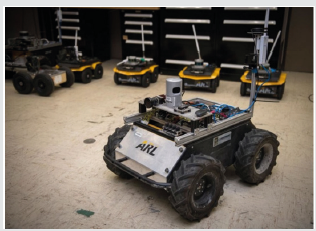
Robots Can Boosts Children’s Education
Educational Robots play a vital role in educating young people but may not replace human teachers completely. As per researchers, scientist say that social robots are demonstrating effective in teaching certain narrow subjects, for instance vocabulary or prime numbers. This study collected in concurrence with academics and involved a review of more than 100 published articles which have shown robots to be effective at increasing outcomes because of their physical presence. However, it also says that leading social robots into the school course would face significant logistical challenges and may carry risks with some children been seen to rely completely on the robots rather than simply using them when they are in difficulty. Authors of study also add “Considering practical considerations of introducing robots in education also brings ethical issues. For example, how far do we want the education of our children to be delegated to machines?” [3,4] (Figure 2).
Figure 2: Illustrates one of the robots used in the University of Plymouth’s Robo21c program, which aims to complement to the school curriculum by developing teachers’ skills and understanding of robotics and programming. Image Credit: University of Plymouth [4].
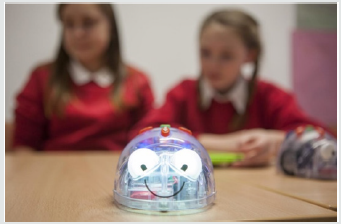
Programming Robots Just by Casual Talking
Robots are getting smarter day by day, but they still need step by step instructions for tasks they didn’t implemented before. For example, before you tell your household robot “make me a bowl of ramen noodles” you may have to teach it how to do that. Since we are not all computer programmers, we would prefer to give instructions in English just like we talk to a person. The robot may have built in programming language with look (pan); use (pan); carry (pan, water tap); fill up (pan, water); carry (pan, heater) and so on. In this research, this software convert’s human sentences such as “Fill a pan with water, put it on the heater, heat the water. When it’s in boiling state, add the noodles” in the robot language. If you had notice you never said, “Turn on the heater.” The robot has to be smart enough to fill in that missing step. The robot accomplished correctly up to 64 percent of the time even when the commands were varied, or environment was different; it was able to perform missing steps. That was three to four times better than previous methods, the researchers reported, but there is still room for improvement [5] (Figure 3).
Figure 3: Illustrates a computer science professor is teaching robots to understand instructions in natural language from various speakers, account for missing information, and adapt to the environment at hand. Image Credit: Image courtesy of Cornell University [5].
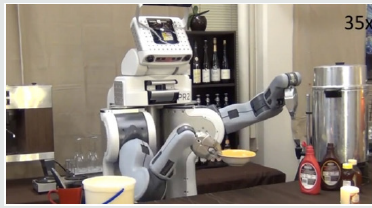
Robots and Kids Learn Together
The Robotic software is based on learning by teaching. When children experience problems in writing they may easily lose confidence and gradually lose interest in learning process. Eventually, their complete education can be affected. When students put themselves in the place of instructor and pass on what they know to their peers, they can regain self-esteem and motivation. Researchers constructed an advanced writing algorithm and implemented them on an existing robot model. With all these algorithms, machine can draw words on demand and then eventually improve. But to do, it uses a very vast database of handwriting examples, which allows it to reproduce common mistakes made by young children while learning. It can also be possible to program the robot so that it addresses the specific difficulties of a student, for example by drawing that is barely readable and improving its form over time. The robotic system is still in the prototype stage that has already been used in primary school lessons with around seventy students ranging from six to eight years old and then individually with a six-year-old child for one hour per week over one month [6] (Figure 4).
Figure 4: Illustrates Kids and robots learning to write together. Image Credit: Image from video courtesy of Ecole Polytechnique Fédérale de Lausanne [6].
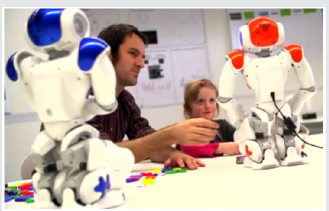
Robotic Help for Deaf Children
Swivel is tunable robot which is placed on a tablet or iPad. It is placed in the classroom and turns to follow people talking. It then uploads video to a secure cloud for streaming. This novel device was developed by University of Manchester and their team to help assess classroom training for students on its deaf education course. This program requires trainees to be assessed in the classroom. The Swivl technology has been used in three locations with five students. The footage is then uploaded to the cloud and forms part of the external, independent assessment process. Then students were able to use the recordings to review their own work in the classroom and imitate on their learning – something that they cannot do on traditional placements. The team is estimating the experiences of both the students and supervisors in order to understand how they can improve and extend the use of the technology [7] (Figure 5).
Figure 5: Illustrates one of the trainees using the technology. Image Credit: The University of Manchester [7].
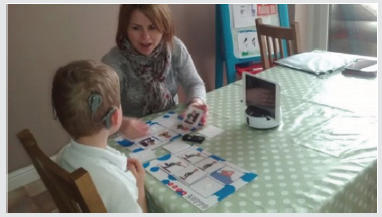
Acknowledgment
Author would like to thank Prof. Navarun Gupta, Prof. Hassan Bajwa, Prof. Linfeng Zhang and Prof. Hmurcik for their academic support. Author also thanks anonymous reviewers for their comments.
References
- NY Post (2018) Finland schools are testing out robot teachers.
- US Army Research Laboratory (2018) Teaching robots to be more reliable teammates for soldiers. ScienceDaily.
- Tony Belpaeme, James Kennedy, Aditi Ramachandran, Brian Scassellati, Fumihide Tanaka (2018) Social robots for education: A review Science Robotics 2018.
- University of Plymouth (2018) Robots will never replace teachers but can boost children’s education. ScienceDaily.
- Cornell University (2014) Robot can be programmed by casually talking to it. Science Daily.
- Ecole Polytechnique Fédérale de Lausanne (2015) Kids and robots learn to write together. ScienceDaily.
- University of Manchester (2015) Training teachers for deaf children gets a robotic helping hand. ScienceDaily.

Top Editors
-

Mark E Smith
Bio chemistry
University of Texas Medical Branch, USA -

Lawrence A Presley
Department of Criminal Justice
Liberty University, USA -

Thomas W Miller
Department of Psychiatry
University of Kentucky, USA -

Gjumrakch Aliev
Department of Medicine
Gally International Biomedical Research & Consulting LLC, USA -

Christopher Bryant
Department of Urbanisation and Agricultural
Montreal university, USA -

Robert William Frare
Oral & Maxillofacial Pathology
New York University, USA -

Rudolph Modesto Navari
Gastroenterology and Hepatology
University of Alabama, UK -

Andrew Hague
Department of Medicine
Universities of Bradford, UK -

George Gregory Buttigieg
Maltese College of Obstetrics and Gynaecology, Europe -

Chen-Hsiung Yeh
Oncology
Circulogene Theranostics, England -
.png)
Emilio Bucio-Carrillo
Radiation Chemistry
National University of Mexico, USA -
.jpg)
Casey J Grenier
Analytical Chemistry
Wentworth Institute of Technology, USA -
Hany Atalah
Minimally Invasive Surgery
Mercer University school of Medicine, USA -

Abu-Hussein Muhamad
Pediatric Dentistry
University of Athens , Greece

The annual scholar awards from Lupine Publishers honor a selected number Read More...





